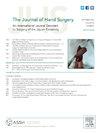Replication of Coupled Movements of the Wrist: A Cadaveric Study of Total Wrist Arthroplasty
IF 2.1
2区 医学
Q2 ORTHOPEDICS
引用次数: 0
Abstract
Purpose
The purpose of this study was to determine how well the active range of motion and the forces required to achieve motions are maintained following cadaveric implantation of the ball-and-socket style total wrist arthroplasty (TWA).
Methods
An active wrist motion simulator was used to produce flexion, extension, radioulnar deviation, dart-thrower’s motion, and circumduction in 14 fresh-frozen cadaveric wrists before and after TWA. Identical tendon displacements were applied to five major wrist flexors and extensors to control motion presurgery and postsurgery. Motion trials were recorded using biplanar video fluoroscopy and digitally reconstructed with 6 degrees of freedom using x-ray reconstruction of moving morphology. Wrist angles were subsequently measured with respect to an anatomically based radial coordinate system. Forces applied to the five actuated tendons were recorded by the simulator throughout all motion trials. Maximum wrist angles, dart-thrower’s motion plane orientation, circumduction ellipse parameters, and peak tendon forces in pre-TWA and post-TWA conditions were compared.
Results
There were no significant differences in maximal flexion, extension, radial, or ulnar deviation angles when comparing preoperative anatomic wrists with the same wrist following implantation of the TWA. Orientation of dart-thrower’s motion planes and circumduction ellipses with respect to the sagittal plane increased after cadaveric surgery, whereas the area of the circumduction ellipses remained similar. Tendon forces were similar in anatomic and TWA wrists apart from flexor forces, which decreased in flexion in TWA wrists.
Conclusions
In our cadaveric setup, the TWA was able to recreate functional motion patterns without significantly increased tendon forces.
Clinical relevance
The results of this study support the assertion that a ball-and-socket style TWA can provide a postoperative range of motion adequate to perform activities of daily living.
腕关节耦合运动的复制:全腕关节置换术的尸体研究。
目的:本研究的目的是确定在尸体植入球窝式全腕关节置换术(TWA)后,活动范围和实现活动所需的力是如何保持的。方法:采用主动腕关节运动模拟器对14例新鲜冷冻尸体腕关节进行TWA前后的屈曲、伸展、尺桡偏移、飞镖运动和绕行。相同的肌腱移位应用于五个主要的腕屈肌和伸肌,以控制手术前和术后的运动。使用双平面视频透视记录运动试验,并使用x射线重建运动形态,以6个自由度进行数字重建。腕关节角度随后根据解剖学基础的径向坐标系进行测量。在所有运动试验中,模拟器记录了施加在五个驱动肌腱上的力。比较twa前后两种情况下的最大手腕角度、投镖者运动平面方向、圆周椭圆参数和肌腱峰值力。结果:术前解剖腕关节与同一腕关节植入TWA后,在最大屈伸、桡骨或尺侧偏角上无显著差异。抛镖者的运动平面和绕行椭圆相对矢状面的方向在尸体手术后增加,而绕行椭圆的面积保持不变。除了屈肌力外,解剖手腕和TWA手腕的肌腱力相似,屈肌力在TWA手腕的屈曲中减少。结论:在我们的尸体装置中,TWA能够在不显著增加肌腱力的情况下重建功能性运动模式。临床相关性:本研究结果支持球窝式TWA可以提供足够的术后活动范围以进行日常生活活动的断言。
本文章由计算机程序翻译,如有差异,请以英文原文为准。
求助全文
约1分钟内获得全文
求助全文
来源期刊
CiteScore
3.20
自引率
10.50%
发文量
402
审稿时长
12 weeks
期刊介绍:
The Journal of Hand Surgery publishes original, peer-reviewed articles related to the pathophysiology, diagnosis, and treatment of diseases and conditions of the upper extremity; these include both clinical and basic science studies, along with case reports. Special features include Review Articles (including Current Concepts and The Hand Surgery Landscape), Reviews of Books and Media, and Letters to the Editor.

 求助内容:
求助内容: 应助结果提醒方式:
应助结果提醒方式:


